Equality, Diversity and Inclusion reports
Executive Summary
The ethnicity pay gap in the NHS is a complex issue with several contributing factors.
Kingston and Richmond NHS Foundation Trust Ethnicity Pay Gap (EPG) Analysis Report 2025 highlights that there are disparities in the average pay between ethnic minority staff and white staff. Kingston and Richmond NHS Foundation Trust are publishing its EPG figures for the first time in line with the NHS Equality Diversity and Inclusion (EDI Improvement Plan.
The report provides detailed analysis on the mean and median ethnicity pay gaps for both Kingston Hospital NHS Foundation Trust, and Hounslow and Richmond Community Healthcare, with a further breakdown by the proportion of minority ethnic staff receiving bonus payments, and the distribution of staff in different pay bands.
Findings show Kingston Hospital NHS Foundation Trust (KHFT) has an estimated mean ethnicity pay gap of 5.09% (£1.31) and a median ethnicity pay gap of 7.14% (£1.62) in 2024. Both have increased since 2023 (from 3.32% / £0.80 and 5.49% / £1.16 respectively). Hounslow and Richmond Community Healthcare (HRCH) has an estimated mean ethnicity pay gap of 5.23% (£1.22) and a median ethnicity pay gap of 8.68% (£1.62), both decreasing since 2023 (from 7.18% / £1.60 and 10.77% / £2.34 respectively).
The KHFT mean ethnicity pay gap has increased from £0.79 in 2023 to £1.31 in 2024, a 65.8% increase (£0.52). The median ethnicity pay gap increased from £1.16 in 2023 to £1.62 in 2024, a 39.7% increase (£0.46).
- The KHFT 2024 mean hourly rate increased for both White and BME staff (White from £23.95 to £25.74 and BME increasing from £23.16 in 2023 to £24.43 in 2024).
The HRCH mean ethnicity pay gap has decreased from £1.60 in 2023 to £1.22 in 2024, a 23.5% decrease (£0.38). The median ethnicity pay gap decreased from £2.34 in 2023 to £1.98 in 2024, a 15.4% decrease (£0.36).
- The HRCH 2024 mean hourly rate increased for both White and BME staff (White staff £23.35 vs BME staff £22.13, resulting in a disparity of £1.22), which led to a decrease in the ethnicity pay gap (£1.22 from £1.60).
The KHFT and HRCH Equality Diversity Inclusion Annual Report 2023-2024 indicates that staff from Black, Asian, and diverse ethnic backgrounds are underrepresented in senior roles within the NHS, which contributes to the pay gap
We will continue to address the ethnicity pay gap and put in place additional actions such as inclusive recruitment & selection practices (including international recruitment) and career development programs to support the advancement of minority ethnic staff.
Introduction
Employers with 250 or more employees are required to publish gender pay gap analysis. In 2017, the UK government published its first ‘Race in the workplace report’, this examines the barriers people from ethnic minorities face in employment in comparison to their white colleagues.
Employers are not required to collect, analyse or publish information on ethnicity pay but many choose to do so as a positive measure to improve workforce progression.
The NHS Equality Diversity and Inclusion Improvement Plan’s Six High Impact Actions, published in June 2023 sets out requirements for NHS Trusts to report its ethnicity pay gap and have actions in place to address gaps identified.
- The regulations require that the following calculations are completed, mirroring the gender pay gap reporting:
- The mean ethnicity pay gap
The mean pay gap is the percentage difference between the average hourly earnings of white staff and ethnic minority staff. It is calculated by dividing total hourly earnings for ethnic minority and white staff (separately) and dividing by the number of employees in each group. The difference between the two is the mean pay gap. - The median ethnicity pay gap
The median pay gap is the percentage difference between the middle value of hourly earnings for white staff and ethnic minority staff. It is calculated by subtracting the median hourly pay of white staff from the median hourly pay of ethnic minority staff, dividing this by the median hourly pay of white staff and multiplying by 100 to give a percentage. - Calculating and analysing both figures helps trusts in making informed decisions and developing targeted strategies to address pay gaps. For example, if the mean pay gap is significantly different from the median, it may indicate the presence of outliers that need further investigation.
- The proportion of minority ethnic staff receiving a bonus payment
- The proportion of white staff receiving a bonus payment
- The proportion of minority ethnic and white staff in each quartile pay band
- The mean ethnicity pay gap
According to a report by the Nuffield Trust, the NHS is the largest employer of ethnic minority staff in England, with over 225,000 employees. The report examines differences in basic pay between ethnic minority staff and white staff, revealing that while there is no significant pay gap for the majority of NHS staff under the Agenda for Change terms, there are variations when comparing specific ethnic groups.
- The Nuffield Trust report also highlights doctors, particularly consultants, have a disproportionate effect on aggregate pay differences due to their higher pay and different ethnic composition. For example, Black/British men earn less on average than any other group in the NHS
- These insights suggest that the ethnicity pay gap in the NHS is influenced by factors such as underrepresentation in senior roles, variations in pay across different ethnic groups, and the impact of higher-paid roles like consultants on overall pay disparities. Addressing these issues requires targeted actions to promote equality, diversity, and inclusion within the NHS workforce.
Purpose
The ethnicity pay gap analysis provides information on the difference in the average pay between all ethnic minority staff and all white staff in our workforce. Recognising the importance of analysing and understanding any disparities in the average pay between different ethnic groups in our workforce.
The purpose of this report is to provide an overview of the Trust’s data as at 31st March 2023.
Kingston and Richmond NHS Foundation Trust was formally known as Kingston Hospital NHS Foundation Trust, and Hounslow and Richmond Community Healthcare as at 31st March 2023. Hounslow services were disaggregated on 1st July, and a merger of Richmond-based staff and Kingston Hospital NHS Foundation Trust took place on 1st November 2024.
This report will provide the ethnicity pay gap for Kingston Hospital NHS Foundation Trust and Hounslow and Richmond Community Healthcare NHS Trust separately, with one action plan moving forward in line with the Trust’s ongoing commitment to equality, diversity and inclusion.
-
- The mean ethnicity pay gap
|
2024 |
|||
|
Mean Hourly Rate |
Difference |
EPG (%) |
|
|
White |
£25.74 |
£0.00 |
0.00% |
|
BME |
£24.43 |
£1.31 |
5.09% |
|
Not Known |
£25.96 |
£0.22 |
0.85% |
Figure 1.
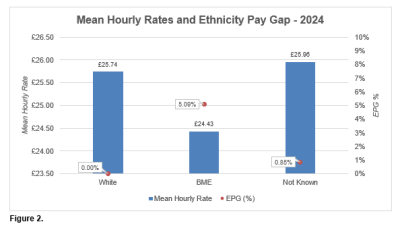
The mean hourly rate for white employees is £25.74 and the mean hourly rate for ethnic minority staff is £24.43. Highlighting a disparity of £1.31, with an estimated mean ethnicity pay gap of 5.09%. It is difficult to determine the exact ethnicity pay gap when the not known mean hourly rate is at £25.96 with a disparity of £0.22.
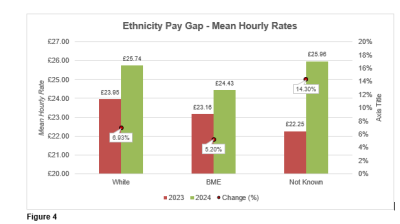
Figures 3 and 4 above show comparable data for 2023 and 2024. In 2023 the mean hourly rate for white employees was £23.95 and the mean hourly rate for ethnic minority staff in 2023 was £23.16, highlighting a disparity of £0.79. In 2024 the hourly rate has increased for both groups (ethnic minority £24.43 vs white £25.74) showing a disparity of £1.31, increasing the ethnicity pay gap by £0.52 in 2024. The Not Known has also seen an increase since 2023 with an hourly rise of £3.71, making it difficult to determine the exact ethnicity pay gap.
The median ethnicity pay gap
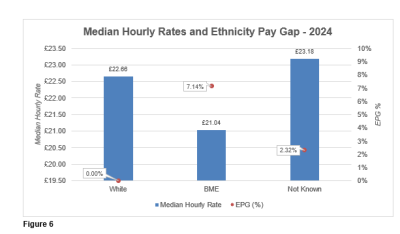
The median hourly rate for white employees is £22.66 and the median hourly rate for ethnic minority staff is £21.04. Highlighting a disparity of £1.62, with an estimated median ethnicity pay gap of 7.14%. It is difficult to determine the exact median ethnicity pay gap when the not known median hourly rate is at £23.18 with a disparity of £0.52.
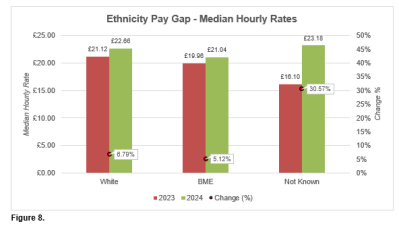
Figures 7 and 8 show comparable data for 2023 and 2024. In 2023 the median hourly rate for white employees was £21.12 and the median hourly rate for ethnic minority staff was £19.96, highlighting a disparity of £1.16. In 2024 the hourly rate has increased for both groups (ethnic minority at £21.04 vs white at £22.66 showing a disparity of £1.62), increasing the ethnicity pay gap accordingly in 2024. The Not Known has also seen an increase since 2023 with the median hourly rate rising to £23.18, from £16.10 showing an £7.09 increase, making it difficult to determine the exact median ethnicity pay gap.
The mean and median by ethnic origin grouping
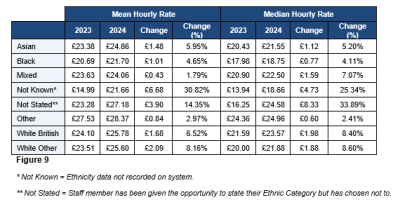
The above figure highlights both the mean and median hourly rate broken down by the different ethnic groups for 2023 and 2024.
Figure 9 features the category Other had the highest mean and median hourly rate, followed by White British, White Other and Not Known, Black and Asian falling into the lowest hourly rates for 2023 and 2024.
The proportion of minority ethnic staff receiving a bonus payment
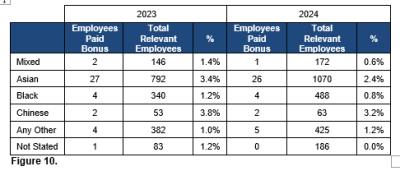
The table above suggests 27 of staff identifying as Asian were the highest category from the ethnic minority groups to receive a bonus payment in 2023, followed by Black and Any Other at 4, then Chinese and Mixed with 2. In 2024 there was a slight change with Asian being the highest category from the ethnic minority groups at 26, followed by Any Other with 5 and Black with 4.
A total of 39 ethnic minority staff received a bonus payment in 2023 and 38 received a bonus payment in 2024. These figures do not include Not Stated.
The proportion of white staff receiving a bonus payment

42 White staff received a bonus payment in 2023 and 41 received a bonus payment in 2024.
The proportion of minority ethnic and white staff in each quartile pay band

Figure 12 highlights the proportion of minority ethnic and white staff in each quartile pay band. One of the reasons for the ethnicity pay gap is that there are more White staff in the Upper Quartile than ethnic minority staff.
Figure 12 demonstrates that Upper and Lower Quartiles are predominantly White, while the Lower and Upper Middle values tend to lean towards ethnic minority staff.
The mean ethnicity pay gap
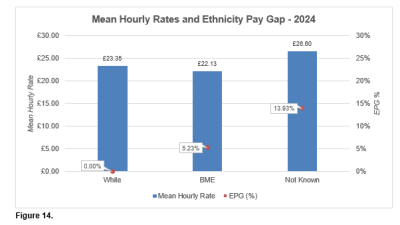
The mean hourly rate for white employees is £23.35 and for ethnic minority staff £22.13, highlighting a disparity of £1.22, with an estimated mean ethnicity pay gap of 5.23%. The Not Known mean hourly rate is £26.60 with a disparity of £3.25 or 13.93%.
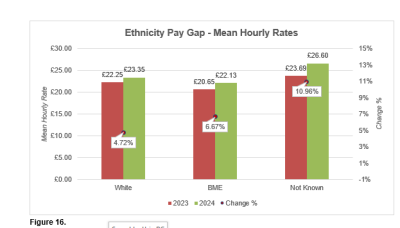
Figures 15 and 16 above show comparable data for 2023 and 2024. In 2023 the mean hourly rate for white employees was £22.25 and for ethnic minority staff £20.65, highlighting a disparity of £1.60. In 2024 the hourly rate has increased for both groups (white £23.35 vs ethnic minority £22.13 resulting in a disparity of £1.22), which has resulted in a decrease to the ethnicity pay gap of £0.38 in 2024 (£1.22 from £1.60). The Not Known has also seen an increase since 2023 with an hourly rise of £2.91 (£26.60 from £23.69).
The median ethnicity pay gap
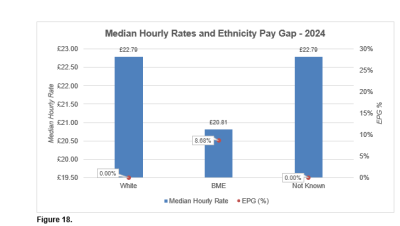
The median hourly rate for white employees in 2024 is £22.79 and for ethnic minority staff, £20.81, highlighting a disparity of £1.98, with an estimated median ethnicity pay gap of 8.68%. The Not Known median hourly rate coincidentally matches the White median hourly rate.
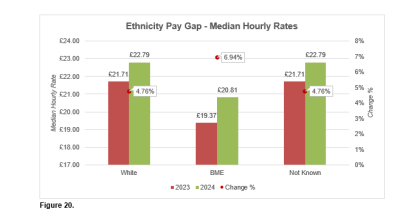
Figures 19 and 20 show comparable data for 2023 and 2024. In 2023 the median hourly rate for white employees was £21.71 and for ethnic minority staff, £19.37, highlighting a disparity of £2.34. In 2024 the hourly rate has increased for both groups (white £22.79 vs ethnic minority £20.81, showing a disparity of £1.98, decreasing the ethnicity pay gap in 2024. The Not Known has also seen an increase since 2023 with the median hourly rate rising to £22.79 from £21.71 showing an £1.09 increase. As per the previous point, the Not Known median hourly rate coincidentally matches the White median hourly rate.
The mean and median by ethnic origin grouping
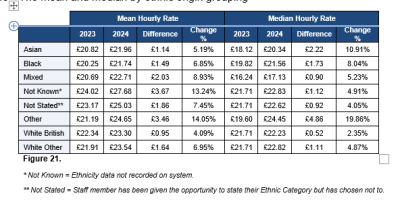
The above figure highlights both the mean and median hourly rate broken down by the different ethnic groups for 2023 and 2024.
Figure 21 features the category Not Known had the highest mean and median hourly rate, followed by Not Stated, White British, Black, Mixed and Asian falling into the lowest hourly rates for 2023 and 2024.
The proportion of minority ethnic staff receiving a bonus payment
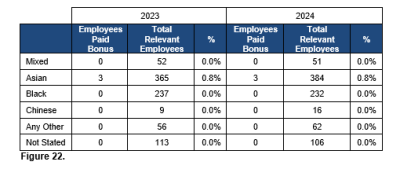
The figure above suggests 3 members of staff identifying as Asian were the only category from the ethnic minority groups to receive a bonus payment in 2023 with the same results for 2024.
A total of 3 ethnic minority staff received a bonus payment in 2023 and 3 received a bonus payment in 2024.
The proportion of white staff receiving a bonus payment

Only 2 White staff received a bonus payment in 2023 and 2 received a bonus payment in 2024 according to figure 23 above.
The proportion of minority ethnic and white staff in each quartile pay band

Figure 24 highlights the proportion of minority ethnic and white staff in each quartile pay band.
Figure 24 demonstrates that Lower Quartile, lower middle and upper middle are predominantly ethnic minorities, while the upper quartile has a majority of white.
Kingston and Richmond NHS Foundation Trust have committed to address any form of discrimination; this includes closing the ethnicity pay gap where identified.
The action plan below in Appendix 1 outlines how the Trust proposes to reduce the ethnicity pay gap over the coming year in line with its EDI High Impact Action plan.
The table below provides the current actions in place to support improvement of the Trust’s ethnicity pay gap. These actions will be refreshed in 2025 as part of our wider equality, diversity and inclusion objectives and plans.
|
EDI Objective
|
Action(s) |
Progress |
Timeframe |
Accountable Lead |
|
Staff Networks – We will continue to support our staff networks as a safe way for staff to have peer support and open conversations. |
Minority Ethnic Network for Doctors (MEND) and BADEN have been given annual budgets to deliver objectives that ensure staff from all ethnicities can be supported at work |
Both networks have delivered events to support BME staff in the workplace and educate line managers on combatting race discrimination, foster allyship and influence inclusive and anti-racist policies in the trust. Workshops included Show Racism the Red Card, Kayne Kawasaki Cultural Theorist Event, in conversation with Calvin Morley with over 100 attendees inclusive. The series of Staff Story events delivered by the MEND network in January and February 2025 provided examples of poor treatment of doctors from BME backgrounds. The learning from these sessions and comments received from participants will inform the existing action plan. BADEN staff network events for Black History month highlighted above have been delivered to support anti racist learning, educate participants on understanding whiteness; alongside this are events to celebrate different cultures. Show Racism the Red Card training is being repeated on an ongoing basis with managers and non-BME staff, the main target audience.
BME Staff Network objectives for 2025 will continue to provide awareness of issues and support to both BME and non BME staff. |
Ongoing |
Deputy Chief People Officer – EDI & People Strategy |
|
Leadership – develop inclusive and compassionate leadership to support a diverse workforce. |
Provide Leadership Development programmes that support BME staff into leadership roles, both managerial and clerical |
|
Ongoing
|
Deputy Chief People Officer – EDI & People Strategy and Deputy Chief People Officer – OD & Wellbeing |
|
We will be running leadership development programmes in the forthcoming year to support managers to ensure BME staff are supported throughout the trust. Training provision for all managers in behaviours that demonstrate the trust’s new values will be provided in 2025 with a particular emphasis on how to lead inclusively.
|
2025/26 objectives |
Chief People Officer Supported by Deputy Chief People Officers |
||
|
Administrative and healthcare assistant Development programmes are now in place that support the development of all staff and are designed to eliminate bias in recruitment and talent management. These programmes are now ongoing and part of the trust’s development offer to all staff. |
Ongoing |
Deputy Chief Nurses (supported by HR Business Partners) |
||
|
De-bias Recruitment and Selection |
Review Recruitment and selection practices.
Ensure recruitment panels are balanced in terms of ethnicity where possible or include specialists trained in anti-bias in recruitment and selection. |
Following a comprehensive review of recruitment practices, we will introduce robust actions to support a fair and inclusive recruitment process. We anticipate this will improve the experience of candidates’ recruitment within our organisation. We will continue to de-bias recruitment and selection, by making full use of positive action and explore opportunities to recruit internationally – ensuring international qualifications are appropriately recognised.
|
Ongoing |
Deputy Chief People Officer – EDI & People Strategy |
|
We will build on the progress that has already been made with 45 Recruitment Inclusion Specialists continuing to sit on interview panels for band 7 and above roles |
Ongoing |
Deputy Chief People Officer – EDI & People Strategy |
||
|
Executive Search |
Ensure that external executive search agencies supporting the recruitment to senior roles are working to a brief with clear criteria for diverse and representative shortlists. |
2025/26
|
Deputy Chief People Officer – EDI & People Strategy |